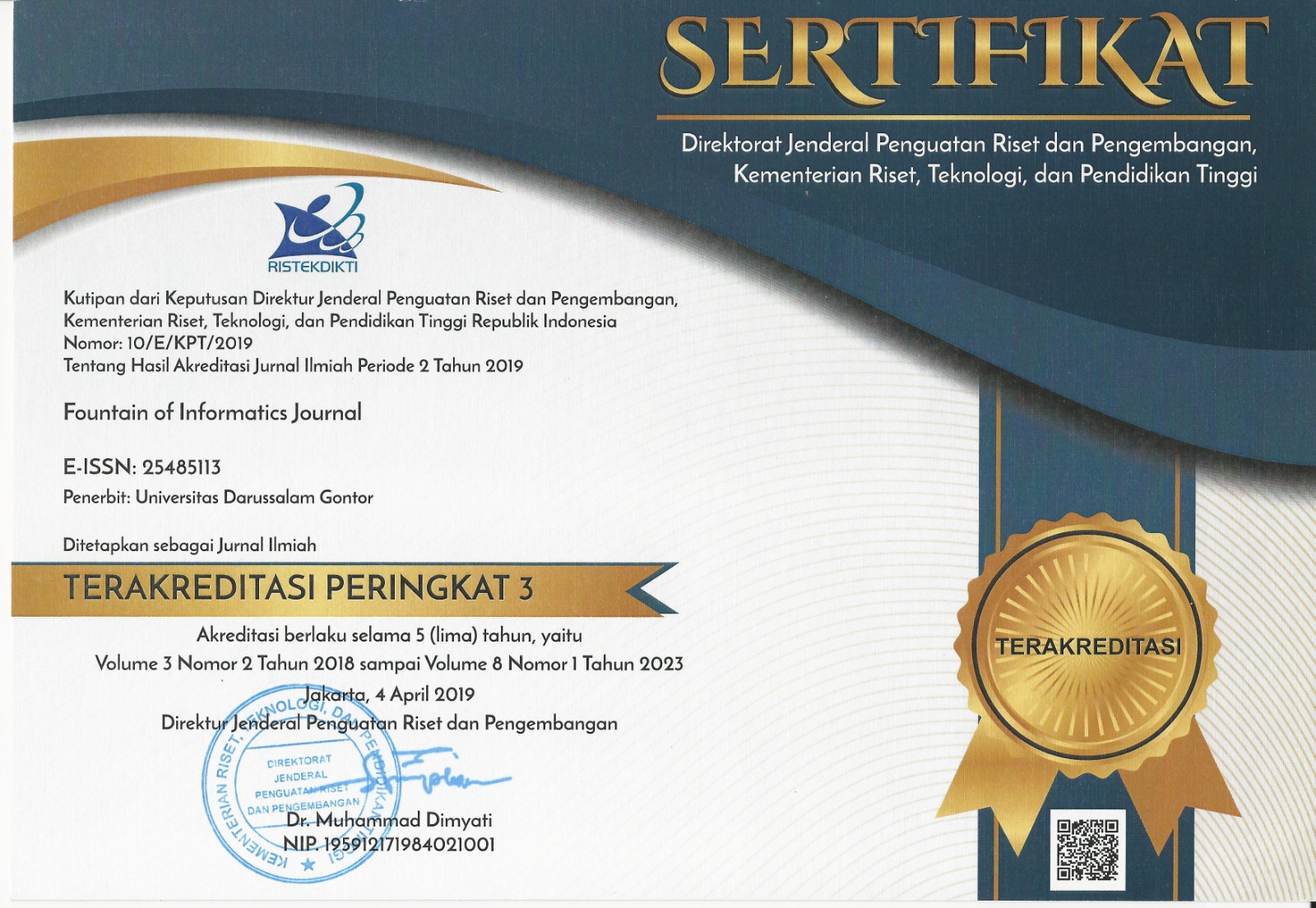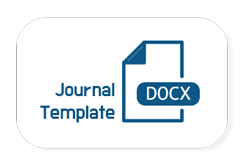Klasifikasi Tingkat Keparahan Penyakit Leafblast Tanaman Padi Menggunakan MobileNetv2
DOI:
https://doi.org/10.21111/fij.v8i1.9419Keywords:
Klasifikasi, leafblast, padi, citra, model pre-trained, MobileNetV2.Abstract
AbstrakPadi merupakan tanaman pangan pokok di Indonesia, dan produksinya merupakan kunci ketahanan pangan negara. Keberhasilan panen merupakan faktor penting dalam pencegahan impor bahan pangan pokok. Tantangan terbesar dalam memanen tanaman adalah adanya virus, jamur, dan hama yang dapat merusak tanaman. Penelitian ini bertujuan untuk membuat sistem klasifikasi tingkat keparahan penyakit daun pada tanaman padi yang terkena penyakit blas daun dengan bantuan algoritma machine learning. MobileNetV2 adalah arsitektur Convolutional Neural Network (CNN) yang menggunakan Depthwise Separable Convolution untuk membangun model yang ringan dan dirancang untuk mengatasi proses yang memiliki resource yang berlebih. Dataset yang digunakan pada penelitian ini merupakan hasil murni observasi peneliti yang sudah divalidasi oleh ahli dengan total 300 data asli. Model MobileNetV2 ternyata sangat berhasil dalam mengklasifikasikan objek, dengan akurasi 78,33%. dengan hasil penelitian ini, petani dapat terbantu dalam mengenali tingkat keparahan penyakit leafblast pada tanaman padi sehingga pemberian bahan kimia berupa fungisida sesuai dengan dosis anjuran tingkat keparahan. Kata kunci: Klasifikasi, leafblast, padi, citra, model pre-trained, MobileNetV2. Abstract[Classification Of Rice Blast Disease Using MobileNetV2] Rice is a staple food crop in Indonesia, and its production is key to the country's food security. Successful harvesting is an important factor in preventing imports of staple foods. The biggest challenge in harvesting crops is the presence of viruses, fungi, and pests that can damage plants. This research aims to create a classification system for leaf disease severity in rice plants affected by leaf blast disease with the help of machine learning algorithms. MobileNetV2 is a Convolutional Neural Network (CNN) architecture that uses Depthwise Separable Convolution to build lightweight models and is designed to overcome processes that have excessive resources. The dataset used in this study is the result of pure researcher observations that have been validated by experts with a total of 300 original data. The MobileNetV2 model turned out to be very successful in classifying objects, with an accuracy of 78.33%. with the results of this study, farmers can be helped in recognizing the severity of leafblast disease in rice plants so that the provision of chemicals in the form of fungicides in accordance with the recommended dose of severity.Keywords: Classification, leafblast, rice, image, pre-trained model, MobileNetV2References
[1] S. Agustiani, Y. Tajul Arifin, A. Junaidi, S. Khotimatul Wildah, and A. Mustopa, “Klasifikasi Penyakit Daun Padi menggunakan Random Forest dan Color Histogram,†J. Komputasi, vol. 10, no. 1, 2022, doi: 10.23960/komputasi.v10i1.2961.[2] T. Suganda, E. Yulia, F. Widiantini, and H. Hersanti, “Intensitas Penyakit Blas (Pyricularia oryzae Cav.) pada Padi Varietas Ciherang di Lokasi Endemik dan Pengaruhnya terhadap Kehilangan Hasil,†Agrikultura, vol. 27, no. 3, pp. 154–159, 2016, doi: 10.24198/agrikultura.v27i3.10878.[3] S. Indrayani, A. Nasution, and E. S. Mulyaningsih, “Analisis ketahanan padi gogo dan padi sawah (Oryza sativa L) terhadap empat ras penyakit blas (Pyricularia grisea Sacc),†J. Agric., vol. 3, no. 1, pp. 53–62, 2013.[4] A. Nasution and B. Nuryanto, “Penyakit Blas Pyricularia grisea pada Tanaman Padi dan Strategi Pengendaliannya,†Iptek Tanam. Pangan, vol. 9, no. 2, pp. 85–96, 2015.[5] D. Eka Kusumawati and I. Istiqomah, “POTENSI AGENSIA HAYATI DALAM MENEKAN LAJU SERANGAN PENYAKIT BLAS (Pyricularia oryzae) PADA TANAMAN PADI,†VIABEL J. Ilm. Ilmu-Ilmu Pertan., vol. 14, no. 2, pp. 1–13, 2020, doi: 10.35457/viabel.v14i2.1235.[6] R. Indraswari, R. Rokhana, and W. Herulambang, “Melanoma image classification based on MobileNetV2 network,†Procedia Comput. Sci., vol. 197, pp. 198–207, 2021, doi: 10.1016/j.procs.2021.12.132.[7] M. U. Hossain, M. A. Rahman, M. M. Islam, A. Akhter, M. A. Uddin, and B. K. Paul, “Automatic driver distraction detection using deep convolutional neural networks,†Intell. Syst. with Appl., vol. 14, 2022, doi: 10.1016/j.iswa.2022.200075.[8] M. Toğaçar, Z. Cömert, and B. Ergen, “Intelligent skin cancer detection applying autoencoder, MobileNetV2 and spiking neural networks,†Chaos, Solitons and Fractals, vol. 144, p. 110714, 2021, doi: 10.1016/j.chaos.2021.110714.[9] P. Nagrath, R. Jain, A. Madan, R. Arora, P. Kataria, and J. Hemanth, “SSDMNV2: A real time DNN-based face mask detection system using single shot multibox detector and MobileNetV2,†Sustain. Cities Soc., vol. 66, no. December 2020, p. 102692, 2021, doi: 10.1016/j.scs.2020.102692.[10] C. H. Karadal, M. C. Kaya, T. Tuncer, S. Dogan, and U. R. Acharya, “Automated classification of remote sensing images using multileveled MobileNetV2 and DWT techniques,†Expert Syst. Appl., vol. 185, no. July, p. 115659, 2021, doi: 10.1016/j.eswa.2021.115659.[11] M. Sandler, A. Howard, M. Zhu, A. Zhmoginov, and L. C. Chen, “MobileNetV2: Inverted Residuals and Linear Bottlenecks,†Proc. IEEE Comput. Soc. Conf. Comput. Vis. Pattern Recognit., pp. 4510–4520, 2018, doi: 10.1109/CVPR.2018.00474.[12] K. Thenmozhi and U. Srinivasulu Reddy, “Crop pest classification based on deep convolutional neural network and transfer learning,†Comput. Electron. Agric., vol. 164, no. July, p. 104906, 2019, doi: 10.1016/j.compag.2019.104906.[13] C. R. Rahman et al., “Identification and recognition of rice diseases and pests using convolutional neural networks,†Biosyst. Eng., vol. 194, pp. 112–120, 2020, doi: 10.1016/j.biosystemseng.2020.03.020.[14] Ulfah Nur Oktaviana, Ricky Hendrawan, Alfian Dwi Khoirul Annas, and Galih Wasis Wicaksono, “Klasifikasi Penyakit Padi berdasarkan Citra Daun Menggunakan Model Terlatih Resnet101,†J. RESTI (Rekayasa Sist. dan Teknol. Informasi), vol. 5, no. 6, pp. 1216–1222, 2021, doi: 10.29207/resti.v5i6.3607.[15] M. K. Priya and S. Dhanabal, “Analyses of Nine Different Types of Diseases in Paddy with Hybrid Algorithms using Deep Learning,†IJERT-International J. Eng. Res. Technol., vol. 8, no. 08, pp. 1–7, 2020.[16] A. Chakraborty, D. Kumer, and K. Deeba, “Plant Leaf Disease Recognition Using Fastai Image Classification,†Proc. - 5th Int. Conf. Comput. Methodol. Commun. ICCMC 2021, no. Iccmc, pp. 1624–1630, 2021, doi: 10.1109/ICCMC51019.2021.9418042.[17] M. Koklu, I. Cinar, and Y. S. Taspinar, “Classification of rice varieties with deep learning methods,†Comput. Electron. Agric., vol. 187, no. June, p. 106285, 2021, doi: 10.1016/j.compag.2021.106285.[18] S. Ramesh and D. Vydeki, “Application of machine learning in detection of blast disease in south indian rice crops,†J. Phytol., vol. 11, pp. 31–37, 2019, doi: 10.25081/jp.2019.v11.5476.[19] A. Sagar and J. Dheeba, “On Using Transfer Learning For Plant Disease Detection,†bioRxiv, no. July, p. 2020.05.22.110957, 2020, doi: 10.13140/RG.2.2.12224.15360/1.
Downloads
Submitted
Accepted
Published
Issue
Section
License
Copyright (c) 2023 Imam Fauzi Annur, Jumhurul Umami, Moch. Nasheh Annafii, Niken Trisnaningrum, Oddy Virgantara Putra

This work is licensed under a Creative Commons Attribution-NonCommercial-ShareAlike 4.0 International License.
Please find the rights and licenses in the Fountain of Informatics Journal (FIJ). By submitting the article/manuscript of the article, the author(s) agree with this policy. No specific document sign-off is required.
1. License
The non-commercial use of the article will be governed by the Creative Commons Attribution license as currently displayed on Creative Commons Attribution-NonCommercial-ShareAlike 4.0 International License.Â
2. Author(s)' Warranties
The author warrants that the article is original, written by the stated author(s), has not been published before, contains no unlawful statements, does not infringe the rights of others, is subject to copyright that is vested exclusively in the author, and free of any third party rights, and that any necessary written permissions to quote from other sources have been obtained by the author(s).
3. User/Public Rights
FIJ's spirit is to disseminate articles published are as free as possible. Under the Creative Commons license, FIJ permits users to copy, distribute, display, and perform the work for non-commercial purposes only. Users will also need to attribute authors and FIJ on distributing works in the journal and other media of publications. Unless otherwise stated, the authors are public entities as soon as their articles got published.Â
4. Rights of Authors
Authors retain all their rights to the published works, such as (but not limited to) the following rights;
- Copyright and other proprietary rights relating to the article, such as patent rights,
- The right to use the substance of the article in own future works, including lectures and books,
- The right to reproduce the article for own purposes,
- The right to self-archive the article (please read out deposit policy),
- The right to enter into separate, additional contractual arrangements for the non-exclusive distribution of the article's published version (e.g., post it to an institutional repository or publish it in a book), with an acknowledgment of its initial publication in this journal (Jurnal Optimasi Sistem Industri).
5. Co-Authorship
If the article was jointly prepared by more than one author, any authors submitting the manuscript warrants that he/she has been authorized by all co-authors to be agreed on this copyright and license notice (agreement) on their behalf, and agrees to inform his/her co-authors of the terms of this policy. FIJ will not be held liable for anything that may arise due to the author(s) internal dispute. FIJ will only communicate with the corresponding author.
6. Royalties
Being an open accessed journal and disseminating articles for free under the Creative Commons license term mentioned, author(s) aware that FIJ entitles the author(s) to no royalties or other fees.Â
7. Miscellaneous
FIJ will publish the article (or have it published) in the journal if the article’s editorial process is successfully completed. FIJ's editors may modify the article to a style of punctuation, spelling, capitalization, referencing, and usage that deems appropriate. The author acknowledges that the article may be published so that it will be publicly accessible and such access will be free of charge for the readers as mentioned in point 3.










